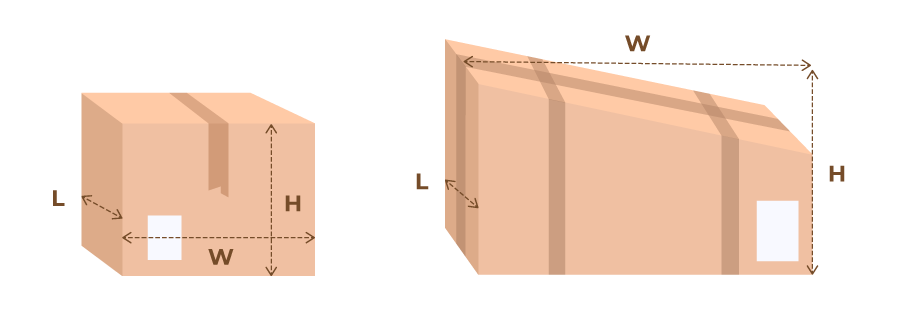Which one is heavier: 1 kg of cotton or 1 kg of iron? While common sense may tell you that they both weigh the same, a physicist will explain to you why 1kg of iron is heavier. As for us, in the logistics world, we will go for 1 kg of cotton and here is why.
Calculating volumetric weight for road, air and sea freight shipments
Air freight chargeable weight
The computation for the air freight chargeable weight is the same as the road freight volumetric weight calculation, with just a conversion factor of 6000, instead of 5000. Therefore, start again by multiplying the length X width X height and divide by 6000 to get the volumetric weight for air freight of the parcel.
Then, the carrier will charge you based on the greater weight, when compared to the gross vs the volume weight.
Continue reading about:
How to calculate the volumetric weight for road freight
The volume weight is what the logistics providers charge you for, if the parcel is too big, but yet not too heavy. What does this mean? For example, cotton does not actually weigh a lot, but it may take a bigger portion of the carriers’ vehicle; therefore, you will be charged for that space, and not the actual weight. To compute the volume and chargeable weight, do the following:
- Measure the parcel;
- Learn what is the volumetric weight constant, or conversion factor, imposed by the shipping company.
Now, here is an example of how to calculate the volumetric weight for road freight:

When computing the road freight volumetric weight, you can either calculate the volumetric weight in meters or centimetres, by multiplying length X weight X height. In most cases, you then need to divide this number by 5000. Some carriers may ask you to divide it by 4000. For the simplicity of the given example, we used centimetres.
Length x width x height = 60 cm x 30 cm x 50 cm = 90 000/5000 = 18 kg
You may also be interested in:
Why should volumetric weight be divided by 5000?
Different carriers may charge you differently based on the type of service or their rules in general; however, for international shipping, the most common volumetric weight constant is 5000 m3/kg. Keep in mind that some carriers may calculate the constant with 4000 m3/kg.
The volumetric weight constant is defined according to the type of freight (air, road, sea), the courier delivering the package and to the destination chosen: is it a domestic delivery, an international delivery, an inland delivery or a delivery to an island? In summary, you will be calculating if your package is dense enough to be charged according to its gross weight or if its volumetric weight will apply instead.
What is the chargeable weight and how to compute it?
After computing the volumetric or dimensional weight of your parcel, you only need to find out which value is higher: the gross weight or the volumetric weight. The final price for your shipment will always take into consideration the higher weight out of the two.
Is the volumetric weight the same as the chargeable weight?
No. Some people assume that, for big loads, the chargeable weight is automatically the volumetric weight. However, this information is not accurate since some parcels might have a higher density and value more than their volumetric weight. In this case, the chargeable weight will be the gross weight of the box.
Sea freight chargeable weight
The calculation for sea freight chargeable weight is slightly different from road and air freight computations. Meaning, when it comes to goods transported by sea, there is a division between the heavy goods and light goods and the carrier charges based on it.
- Cargo with stowage factor less than 40 cubic/ton (or 1.1328 m3/ton), are heavy goods,
- Cargo with stowage factor more than 40 cubic/ton (or 1.1328 m3/ton) are light goods (foam goods).
Read more about:
- Sea freight services
- Sea freight logistics term explained
- How to choose between ocean freight and air freight
Why is the volumetric weight different from the chargeable weight?
The volumetric weight is a measurement adopted by couriers to determine the amount of space a package takes in the transport container. Whether it is a parcel sent by airfreight, road or sea freight, the volumetric weight is calculated by all the transporters as a strategy to maximize their capacity and, of course, their income.
The shipping companies see that all their costs regarding transport are covered. Therefore, if there is a fuel increase or any other unexpected chargers, the courier may reflect this on the constant.
Calculating the dimensional weight or volumetric weight of a parcel was the solution found by the logistics industry to make sure that every van, truck, plane or ship is filled most effectively.
Is gross weight or volumetric weight important when booking with Eurosender?
Our platform can instantly show you a final price for many services; however, if the shipment has some unique specifications, you can request an individual offer. By doing so, our logistics specialists will be able to tailor-make an offer based on your requirements and calculate the final price; therefore, you would not need to make all of these calculations for the volumetric weight.
